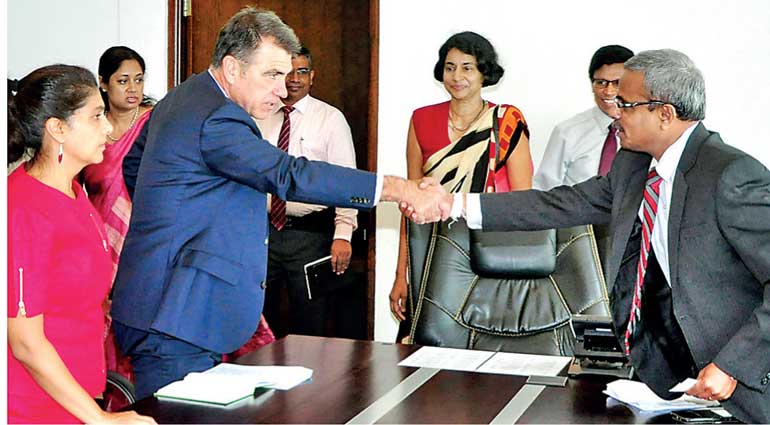Thursday Nov 14, 2024
Thursday Nov 14, 2024
Tuesday, 19 September 2017 00:41 - - {{hitsCtrl.values.hits}}
 Secretary to the Ministry of Industry and Commerce Chinthaka Lokuhetti (right) greets visiting Assistant US Trade Representative for South and Central Asian Affairs Mark Linscott yesterday in Colombo
Secretary to the Ministry of Industry and Commerce Chinthaka Lokuhetti (right) greets visiting Assistant US Trade Representative for South and Central Asian Affairs Mark Linscott yesterday in Colombo
The US has stressed that there shall be no major change in its trade policy towards Sri Lanka following the arrival of its new administration and hinted at stronger economic relations in the future based on the US-Sri Lanka Trade and Investment Framework Agreement (TIFA) inked in Washington in 2002.
“It is tough to predict the future,” stressed the new Washington DC-based visiting Assistant US Trade Representative for South and Central Asian Affairs Mark Linscott yesterday in Colombo.
Linscott was meeting a Sri Lankan Ministry of Industry and Commerce team led by Ministry Secretary Chinthaka Lokuhetti, who was representing Minister of Industry and Commerce Rishad Bathiudeen. He was joined by Commerce Department Director General Sonali Wijeratne and other Department of Commerce officials as well as Minister Bathiudeen’s Senior Advisor Himali Jinadasa. Linscott was joined by the Economic and Commercial Officer of the US Embassy in Colombo William Humnicky.
“The new US administration has a significant shift in change towards several of its trade agreements, mainly the Trans-Pacific Partnership trade deal, and there is a big focus on renegotiating NAFTA as well as correcting our current trade deficits,” said Linscott.
“Despite this, I am not expecting any significant changes in the US’ bilateral trade with Sri Lanka or our Trade and Investment Framework Agreement with Sri Lanka. Being a hub in the region, this is a remarkably exciting time for Sri Lanka and we share the interest in working with Sri Lanka and exploiting its natural advantages for better trade. The WTO Information Technology Agreement and WTO Trade Facilitation Agreement will bring immediate international attention if Sri Lanka moves ahead while I agree that these are challenging initiatives for the country. Also we are pleased about the Government’s private-public partnership vision which TIFA too stresses about. The US is the largest export market for Sri Lanka but our exports to Sri Lanka have not increased in parallel and are down the list, something we need to work on,” he added.
When it comes to Sri Lanka’s international trade in 2016, 27.5% of total Lankan annual exports headed to the US while 2.77% of total imports from the world to Sri Lanka were from the US. According to the Department of Commerce of Sri Lanka, of last year’s total bilateral trade between Sri Lanka and the US, only 16% were imports to Sri Lanka ($ 540 million) while 84% were exports from Sri Lanka to the US ($ 2.8 billion).
Sri Lanka’s exports to the US surged by 33% from $ 2.11 billion in 2012 to $ 2.8 billion in 2016. In the same period, imports from the US to Sri Lanka surged by 130% to $ 540 million. Sri Lanka’s leading exports to the US in 2016 were apparel, clothing accessories and made up textile articles (all three totalling 11.5% of overall exports), solid, new and used tyres (6%), followed by fish, activated carbon and mineral, and cinnamon. Among the leading imports from the US in 2016 were oil cakes (13%), optical and photographic (10%), plastics (5%), medicaments (3%) and wheat and meslin (3%), etc.
Sri Lankan officials apprised the Assistant US Trade Representative on the country’s many new trade initiatives based on the vision of the Unity Government of Sri Lanka and thanked his country for recent US-GSP support.
“We welcome the recent US support by expanding the US’ GSP’s scope, which enhances our exports of travel goods to the US,” said Secretary Lokuhetti, before adding, “Sri Lanka has one of the highest US GSP utilisation rates among other US GSP beneficiaries – we use 85%. Therefore it is time we see more new initiatives via TIFA and are keen to strengthen the TIFA path. Having successfully concluded the inter-sessional meeting in September 2016 at the 12th Joint Council Meeting (JCM) to adopt a five-year action plan, it is time to meet again.”
“We are looking to move on from the past and create a special (trade) plan for Sri Lanka on TIFA. A real example is using trade to increase economic growth. We too definitely want to see TIFA’s follow-up on the progress achieved in Washington,” Linscott responded.
TIFA was signed in July 2002 in Washington D.C. to further enhance trade and economic relations between the two countries.
According to the Department of Commerce of Sri Lanka, from 2012-2016, Sri Lanka’s bilateral trade with the US surged by 43% from $ 2.34 billion to $ 3.34 billion. Even last year Sri Lanka’s YoY bilateral trade with the US increased by 2.14% to $ 3.34 billion from 2015’s $ 3.27 billion.